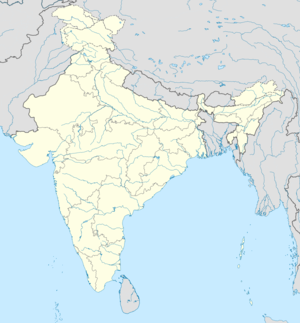
Back চাৰি ধাম AS चार धाम BH চারধাম Bengali/Bangla Char Dham German Char Dham Spanish ભારતના ચારધામ GU भारत के चार धाम HI ಚಾರ್ ಧಾಮ್ (ನಾಲ್ಕು ತಾಣ) KN ചാർ ധാം Malayalam चार धाम MR
The Char Dham (Hindi: चारधाम, romanized: Cārdhām transl. the four abodes), or the Chatur Dhama (Sanskrit: चतुर्धाम, romanized: Caturdhāma),[1] is a set of four Hindu pilgrimage sites in India,[2] consisting of Badrinath, Dwarka, Puri and Rameswaram.[3][4] Badrinath, Dwarka, and Puri are shrines of Vishnu, whereas Rameswaram is a shrine of Shiva.
Defined by Adi Shankara, each dhāma represents a particular yuga, with Badrinath representing Satya Yuga, Rameswaram representing Treta Yuga, Dwarka representing Dvapara Yuga, and Puri representing Kali Yuga.[3][5] Many Hindus believe that visiting these sites can help them achieve moksha.[6]
The Char Dham is not to be confused with the Chota Char Dham which comprises Yamunotri, Gangotri, Kedarnath, Badrinath. It is a Hindu pilgrimage circuit in Uttarakhand which was named by the religious tourism industry.
- ^ Bharati, Agrhananda (3 June 2011). Agents and Audiences. Walter de Gruyter. p. 53. ISBN 978-3-11-080584-0.
- ^ "Chaar Dham Yatra: A True Test of Every Hindu's Quest Towards Spiritual Enlightenment". NewsGram. 20 March 2015. Archived from the original on 23 January 2022.
- ^ a b Dass, Parmeshwar (21 February 2022). "History of Chardham - The Amazing Story of Chota Char Dham". Namaste India Trip. Retrieved 9 November 2023.
- ^ Chakraborty, Yogabrata (28 June 2023). "পুরীধাম ও জগন্নাথদেবের ব্রহ্মরূপ বৃত্তান্ত" [Puridham and the tale of lord Jagannath's legendary 'Brahmarup']. dainikstatesmannews.com (in Bengali). Kolkata: Dainik Statesman (The Statesman Group). p. 4. Archived from the original on 28 June 2023. Retrieved 28 June 2023.
{{cite web}}: CS1 maint: bot: original URL status unknown (link) - ^ ADMIN (5 February 2023). "Char Dham Yatra : Journey To Spiritual Liberation". TEMPLE KNOWLEDGE. Retrieved 9 November 2023.
- ^ Burkhalter-Flueckiger, Joyce (2015). Everyday Hinduism. Wiley. p. 110. ISBN 9781405160117.




